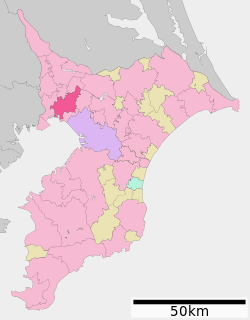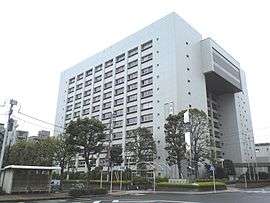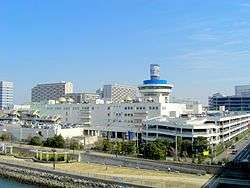Funabashi, Chiba
| Funabashi 船橋市 | |||
|---|---|---|---|
| Core city | |||
|
LaLaPort shopping mall in Funabashi | |||
| |||
 Location of Funabashi in Chiba Prefecture | |||
 Funabashi
| |||
| Coordinates: 35°41′40.4″N 139°58′57.2″E / 35.694556°N 139.982556°ECoordinates: 35°41′40.4″N 139°58′57.2″E / 35.694556°N 139.982556°E | |||
| Country | Japan | ||
| Region | Kantō | ||
| Prefecture | Chiba Prefecture | ||
| Government | |||
| • -Mayor | Toru Matsudo | ||
| Area | |||
| • Total | 85.62 km2 (33.06 sq mi) | ||
| Population (February 1, 2016) | |||
| • Total | 623,679 | ||
| • Density | 7,280/km2 (18,900/sq mi) | ||
| Time zone | Japan Standard Time (UTC+9) | ||
| Postal code(s) | 273 or 274 | ||
| Area code(s) | 047-4 | ||
| - Tree | Camellia sasanqua | ||
| - Flower | Camellia sasanqua | ||
| Phone number | 047-436-2111 | ||
| Address | 2-10-25 Minato-cho, Funabashi-shi, 273-8501 | ||
| Website |
www | ||

Funabashi (船橋市 Funabashi-shi) is a city located in northwestern Chiba Prefecture, Japan. As of February 2016, the city had an estimated population of 623,679 and a population density of 7,280 persons per km². The total area was 85.62 square kilometres (33.06 sq mi). It is the 7th most populous city in Greater Tokyo.
Geography
Funabashi is located in northwestern Chiba Prefecture and makes up one part of the Shimōsa Plateau. The city sits 20–30 meters above sea level, and is relatively flat. Funabashi is crossed by the Tone River, and the small Ebi River is located entirely within city limits. Funabashi formerly had wide, shallow beaches, but much of the coast has been industrialized and transformed by reclaimed land.
Neighboring municipalities
Chiba Prefecture
History
The name "Funabashi" is mentioned in the Kamakura period chronicle Azuma Kagami. However, the name itself is even more ancient, dating from before the Nara period and the Yamatotakeru mythology. Archaeologists have found stone tools from the Japanese Paleolithic period and shell middens from the Jomon period in the area, indicating continuous inhabitation for thousands of years. A number of Shinto shrines and Buddhist temples in the area claim to have been founded in the Nara period or Heian period. During the Muromachi periods, the area was controlled by the Chiba clan. During the Sengoku period, the Chiba clan fought the Satomi clan to the south, and the Late Hojo clan to the west. After the defeat of the Chiba clan, the area came within the control of Tokugawa Ieyasu.
Under the Tokugawa shogunate, the area prospered as a post town on the river crossing of the Tone River, and was largely retained as tenryō under the direct control of the Shogunate and administered through a number of hatamoto. The area was also a favored hunting grounds for the Shogun. During the Boshin War of the Meiji Restoration, Funabashi was the location of a minor skirmish between Tokugawa loyalists under Enomoto Takeaki and the pro-Imperial forces of Okayama Domain and Satsuma Domain, during which most of the town burned down.
After the abolition of the han system, the area eventually became part of Chiba Prefecture. Funabashi Town was one of several towns and villages created on April 1, 1889 under Inba District. The area developed rapidly due to its proximity to Tokyo and the presence of numerous military facilities in the area. On April 1, 1937, Funabashi was elevated to city status through merger with neighboring Katsushika Town and Yasakae, Hoden and Tsukada Villages. The new city was host to numerous military installations in World War II, and was bombed in the air raids on Japan in 1945.
The city developed rapidly in the postwar period, with the development of industries, public housing developments and port facilities. With the annexation of neighboring Ninomiya Town in 1953, the population exceeded 100,000. The population exceeded 300,000 in 1969 and 500,000 in 1982. Funabashi was designated a core city on April 1, 2005 with increased local autonomy from the central government. The population exceeded 600,000 in 2006.
Economy
Funabashi is a regional commercial center and, due to its numerous train connections, a bedroom community for nearby Chiba and Tokyo.
Education
- Nihon University branch campus
- Funabashi has 54 public and one private elementary school, 27 public and one private middle school. The city also has 11 public high schools under the Chiba Prefecture Board of Education and one public high school under the Funabashi City Board of Education. There are also four private high schools.
- Funabashi Keimei High School - Formed in 2011 by the merger of Funabashi Asahi High School (千葉県立船橋旭高等学校) and Funabashi Nishi High School (千葉県立船橋西高等学校).[1]
Transportation
Railway
Higashi-Funabashi - Funabashi - Nishi-Funabashi - Shimōsa-Nakayama
- Keisei Electric Railway - Keisei Main Line
- Shin-Keisei Electric Railway - Shin-Keisei Line
- Futawamukōdai - Misaki - Takifudō - Takanekōdan- Takanekido - Kita-Narashino - Narashino- Yakuendai - Maebara
- Hokusō Railway - Hokusō Line
- Tobu Railway - Tobu Noda Line
- Tōyō Rapid Railway - Tōyō Rapid Line
- Tokyo Metro Tōzai Line
Highway
- Keiyō Road
- Higashi-Kantō Expressway
- Japan National Route 14
- Japan National Route 16
- Japan National Route 296
- Japan National Route 357
- Japan National Route 464
Sister city relations
 – Hayward, California, USA,[2] from November 7, 1986
– Hayward, California, USA,[2] from November 7, 1986 – Odense, Denmark[3] from April 6, 1989
– Odense, Denmark[3] from April 6, 1989 – Xi’an, China[3] from November 2, 1994
– Xi’an, China[3] from November 2, 1994
Local attractions
Notable structures
- Funabashi Auto Racing
- Funabashi Racecourse
- Nakayama Racecourse
- LaLaPort shopping mall, one of the largest in Japan
- SSAWS indoor ski slope (closed and demolished in 2003)
- Japan's first large-format IKEA store, built on the site of SSAWS
Notable places
- Funabashi Shrine
- Ninomiya Jinja
- Narashinohara
- Kūtei-kan
- Meiji Tennō Chūhitsu no Tokoro no Hi
- Gyōda Musen
- Cherry blossoms on the Ebi River
Notable people from Funabashi
- Funassyi – Unofficial city mascot
- Hiroki Aiba – dancer and singer
- Kazuyuki Fujita – professional wrestler
- Sayaka Ichii – musician
- Atsushi Itō – actor
- Yuko Kavaguti – figure skater
- Mai Kuraki – singer
- Fumie Kurotori – Olympic gold medalist swimmer
- Manabu Namiki – video game designer
- Yoshihiro Natsuka – professional soccer player
- Katsuhiko Nishijima – Anime director
- Michiko Nishiwaki – Actress, stunt woman
- Yoshihiko Noda – politician, former Prime Minister of Japan
- Hanako Oku – musician
- Shunzo Ono – professional soccer player
- Tamao Satō – actress
- Takashi Sekizuka – professional soccer player
- Mariko Shiga – musician
- Keiko Terada – singer (Show-Ya)
- Akeno Watanabe – voice actress
- Azusa Yamamoto – gravure idol
- Tomohisa Yamashita – musician
- Risa Yoshiki – model, actress, singer
Notable Companies from Funabashi
- Mugen Seiki - A remote control car manufacturer.
References
- ↑ "A Brief Introduction of Funabashi Keimei High School" (PDF version). Funabashi Keimei High School. Retrieved on June 24, 2015.
- ↑ "US-Japan Sister Cities by State". Asia Matters for America. Honolulu, HI: East-West Center. Retrieved 20 November 2015.
- 1 2 "International Exchange". List of Affiliation Partners within Prefectures. Council of Local Authorities for International Relations (CLAIR). Retrieved 21 November 2015.
External links
| Wikimedia Commons has media related to Funabashi, Chiba. |
 Funabashi travel guide from Wikivoyage
Funabashi travel guide from Wikivoyage- Official website (Japanese)


